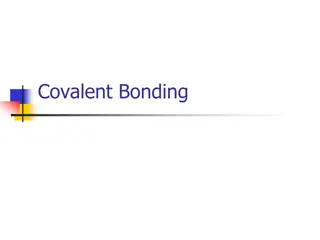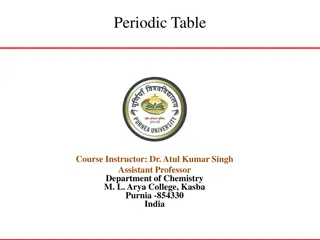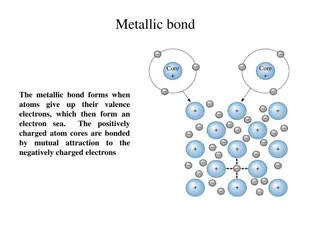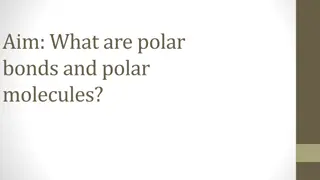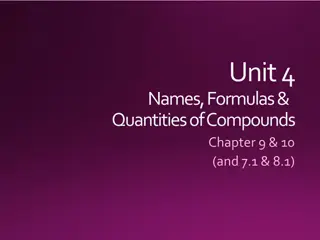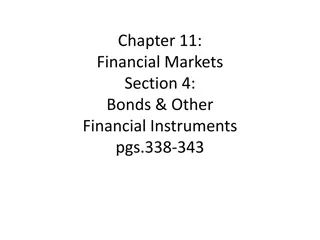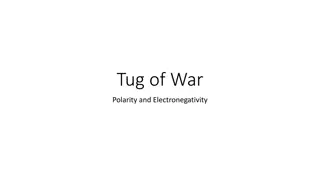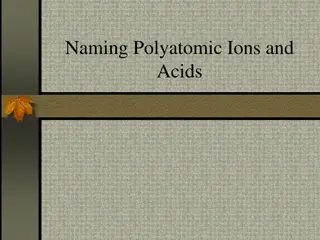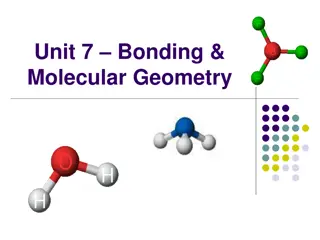Understanding Covalent Bonds and Nomenclature
Explore the concepts of covalent bonding, where electrons are shared between atoms, leading to the formation of stable molecules. Learn the nomenclature rules for naming covalent compounds using prefixes and root names. Discover the nature of diatomic molecules and the naming conventions for acids.
Download Presentation

Please find below an Image/Link to download the presentation.
The content on the website is provided AS IS for your information and personal use only. It may not be sold, licensed, or shared on other websites without obtaining consent from the author. Download presentation by click this link. If you encounter any issues during the download, it is possible that the publisher has removed the file from their server.
E N D
Presentation Transcript
Recall What 2 things are needed to create an IONIC bond: Therefore, what do you think creates a COVALENT bond:
Covalent Bonds What happens to electrons in covalent bond? Electrons shared between atoms, not given or taken completely. Atomic orbitals are combined to form molecular orbitals. Generally bond between nonmetal and nonmetal. Why? 3 trends need to be taken into account. Electron affinity, Ionization energy, and electronegativity differences between atoms are small. Example: CH4
Moleculea neutral group of atoms that are held together by covalent bonds. Molecular formula shows the types and numbers of atoms combined in a single molecule of a compound. Example: CH4 Concept check: What is the difference between a molecule and a polyatomic ion?
Formation of Covalent Bond Nature favors chemical bonding why? Makes the atoms more stable. potential energy is lowered when the atoms are bonded. Lower energy = more stable.
Covalent CompoundsNomenclature Rules Binary Compounds Prefixes: Mono = 1 Di = 2 Tri = 3 Tetra = 4 Penta = 5 Hexa = 6 Hepta = 7 Octa = 8 Nona = 9 Deca = 10 Element with smaller group # is always given first (similar to cation in ionic bonding). Second element combines prefix with suffix ide. If second element begins with vowel, the o- or a- in the prefix is dropped. Do not simplify subscripts in covalent compounds P4O10 Example Prefix indicating number of atoms contributed by second element Prefix needed if first element contributes more than one atom Root name of second element + ide Name of first element
Covalent CompoundsNomenclature N2O As2O5 Carbon Tetrafluoride CO Sulfur Trioxide
Diatomic Molecule Diatomic molecule: A molecule in which there are only two atoms. F2, Cl2, Br2, I2, H2, O2, N2 HINT: KNOW THESE We name diatomic molecules as gases F2 = fluorine gas
Acids 2 types: Binary Acids contain H and another element, usually a halogen. 1.) Put hydro- as prefix for H. 2.) Use ic as suffix for second element. Example HCl = hydrochloric acid Oxyacids contain H, O, and a third element (mostly H paired with a polyatomic ion). 1.) Identify anion. 2.) if the anion suffix is ate replace it with ic 3.) if the anion suffix is ite replace it with ous Example HNO3 = Nitric Acid
Practice in your notes H2S H3P HCl HF
Bell Ringer N3Cl8 Se4Br9 HBr hydrosulfuric acid Disilicon hexiodide Sulfur nonabromiade
BELLRINGER (5 Minutes) P2O5 Si4I7 HBr HCl Hydronitric acid Hydroselenic acid triphosphorus pentoxide trinitrogen nonoxide
Hydrocarbons Hydrocarbons = the simplest organic compounds Contain only carbon and hydrogen 3 types of straight-chain hydrocarbons Alkanes completely saturated hydrocarbons (no double or triple bonds) Go by the formula CnH2n+2 End in suffix -ane Alkenes contain a double bond End in suffix -ene Alkynes contain a triple bond End in suffix -yne
Need to know first ten alkane hydrocarbons CH4 Methane C2H6 Ethane C3H8 Propane C4H10 Butane C5H12 Pentane C6H14 Hexane C7H16 Heptane C8H18 Octane C9H20 Nonane C10H22 Decane
Octet Rule Atoms undergo bonding in order to satisfy the octet rule. Octet rule: Atoms want to be noble gas-like . Chemical compounds tend to form so that each atom has 8 electrons, either by gaining, losing, or sharing electrons
Exceptions to Octet Rule Hydrogen forms only one bond to have two valence electrons. Group 13 Has three valence electrons. Tends to form three bonds. Some elements can form an expanded octet if bound to highly electronegative atoms. Example: SF6 Expanded octet involves empty d orbitals to fit extra electrons.
Lewis Structures What are they?? A formula where atomic symbols represent nuclei and inner shell electrons, and dot pairs represent valence and bonded electrons. What are they used for?? Gives us a way to visualize bonding between atoms Represents where electrons are located Gives relative bond strengths to establish reactivity of molecules.
Lewis Structures Six Steps: 1.) Determine types of atoms in molecule. Example: CH3I 2.) Write electron dot notation for each atom. 3.) Determine the total number of valence electrons available. 4.) Arrange atoms with LEAST electronegative atom in the center (exception: H), and place one shared pair of electrons between each of the atoms. 5.) Fill in valence shells of atoms with unshared electrons (lone pairs). 6.) Count electrons to make sure all available valence electrons are accounted for. ***** Add all atoms (except H) first, then fill in molecule with Hydrogens
Practice with Lewis Structures Draw the Lewis structures for the following molecules: NH3 H2S SiH4 PF3
Draw structures for the following molecules: CH3F BF3 SF6
Whiteboarding Practice Draw the Lewis structures for the following molecules: SiH4 Pl3 Chlorine Gas H2S CCl2F2 AlCl3 C2F6 SF6
Lewis Structure Bellringer H2O NH3 PCl5 BF3 CH4 HCl
Before we go any further Try the Lewis structure for ions: -Negative charge: add the electrons -Positive charge: remove the electrons Ammonium Peroxide Try the Lewis structure for C2H4.
Single and Multiple Covalent Bonds Single bond two electrons shared Also called sigma bond, or bond. Examples: H2 Double bond four electrons shared Consists of one sigma and one pi bond. Example: O2 Triple bond six electrons shared Consists of one and two bonds. Example: N2
Lewis structures with multiple bonds Multiple bonds become evident in lewis structures when there are not enough valence electrons after adding lone pairs. Examples: CH2O CO2 HCN
Characteristics of a Covalent Bond Bond length the average distance between two bonded atoms. Depends on type of bond: single, double, or triple. Bond Dissociation Energy The energy required to break 1 mol of a specific chemical bond (always endothermic). Indicates strength of a bond
Relative Bond Lengths and Strengths Bond length the more shared pairs = the shorter the bond. Single > Double > Triple Bond Strength the more shared pairs = the stronger the bond. Triple > Double > Single
Bellringer Draw Lewis structures for the following molecules: HCl BF3 CH4 PCl5 SF6 NH3 H2S
VSEPR Theory What is it? Regions of electron density want to be as far apart on molecule as possible Regions of electron density around a central atom: Lone pairs Surrounding atoms
There are many other sub- shapes that are formed due to lone pairs.
Hybridization Orbitals of similar energy mix to produce new orbitals (hybrids) Creates optimal space around nucleus for atoms to bond.
Molecular Shape Practice Draw the Lewis Dot structure, name its shape and hybridization Boron trichloride BSF Carbonate (the ion) Nitrogen pentafluoride PFBr2
Polarity Based on electronegativity differences. Polar molecule = uneven distribution of electrons Nonpolar = even distribution 2 ways to be nonpolar: ALL atoms attached to the central atom are the SAME No lone pairs on the CENTRAL ATOM
Identify the bond as polar or nonpolar H H O Cl C Cl H N B F F F
Non-polar and Polar Covalent Bonds Dipole a molecule that contains both positively and negatively charged regions (unequal sharing of electrons). Two ways to show Arrow starts at electron poor region, points to electron rich region Partial negative ( -) and partial positive signs ( +) Nonpolar bonds do not contain a dipole.
Identify the dipole in the following molecules NH3 CH3F SF6 BF3 CCl4
Molecular Shape and Polarity Practice Draw the Lewis Dot structure, name its shape, show the dipoles (if any), and state polar/nonpolar Boron trihydride BSF Carbonate (the ion) Nitrogen pentafluoride PFBr2
Bellringer (5 min): Determine type of bond that will be formed 1. C O 2. K Br 3. Mn O 4. S Cl 5. P Br 6. Al Cl 7. F F 8. Ca Se 9. Li S 10.C I
Mixed Nomenclature Test Nomenclature Bell Ringer 1. Dinitrogen monoxide 2. Potassium bromide 3. Nitrous acid 4. Acetic acid 5. Calcium hydroxide 6. Lead (II) chlorate 7. Sulfur hexafluoride 8. Na2SO4 9. HClO3 10. CBr4 11. Cu3P 12. HI 13. V2O5 14. PCl3



